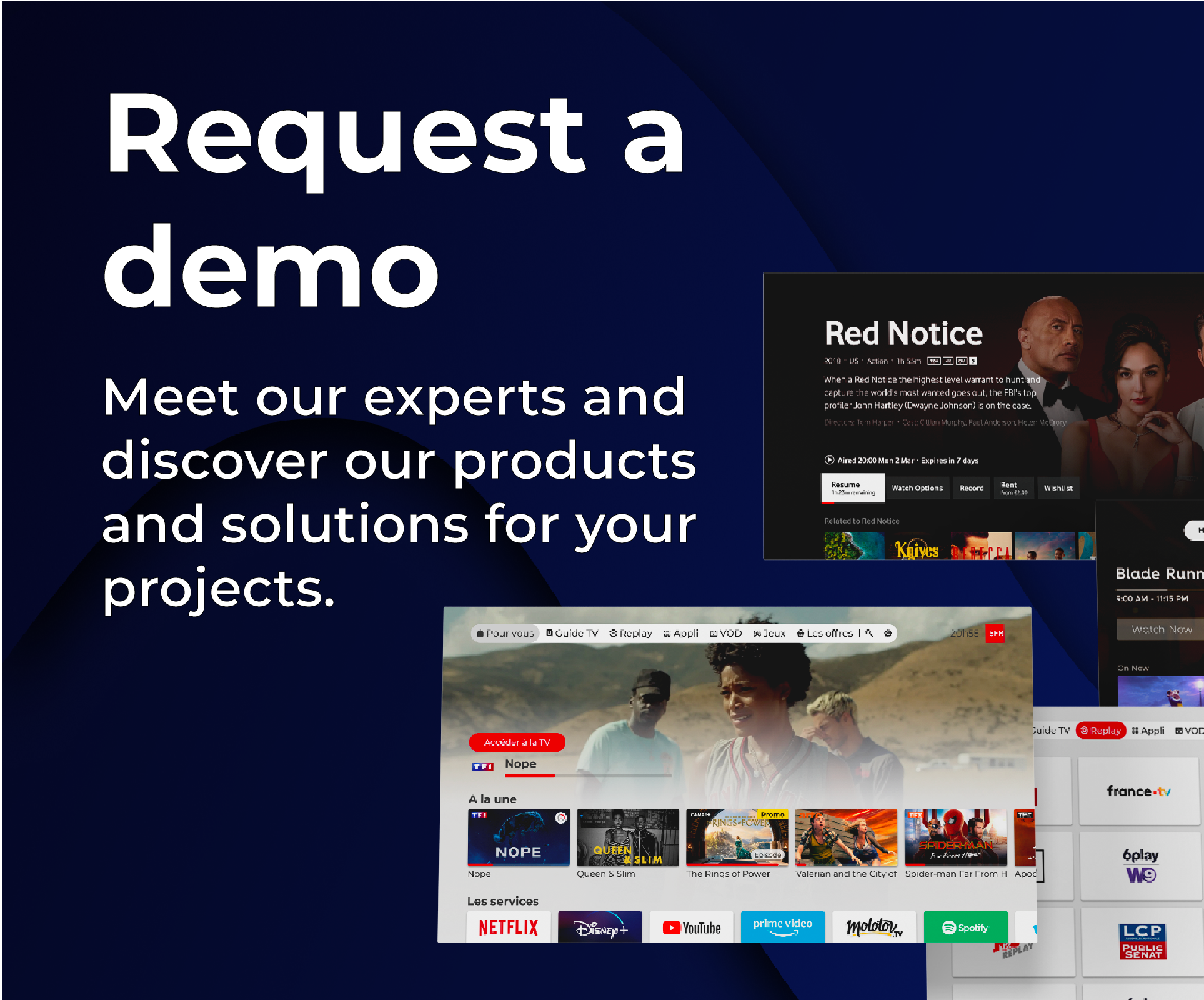Television is unrecognisable from ten years ago, and the advent of Android TV has played a significant role in this transformation. Huge players such as Amazon, Huawei, Roku and Google entered the TV market. They quickly progressed what had been a fairly stagnant medium (from a consumer perspective) for years up until then.
TV users, spurred on by relentless digital transformation and the exponential growth of smartphone usage, began to demand new and more personalised services, with voice controls, tailored content recommendations and cross-device ubiquity thrown into the mix.
>> Download: “Tactical guide, the 5 best practices for a unified cross-device strategy”
One of these players – Google’s Android TV – has seen huge growth in recent years. In 2020 alone it grew by more than 80%, and as of January 2022, it reported having 110 million monthly active users – with some experts predicting it will be the dominant OS by 2026, even though Amazon has made Smart TVs a priority.
This promising growth shows no signs of slowing down and presents a gigantic opportunity for forward-thinking operators wanting to reach new customers and audiences.
Businesses are beginning to realise the scale of the opportunity available, with the number of projects executed through Android TV’s Operator Tier going from eight to 160 between 2016 and 2020, and now reaching over 250 globally – including the likes of Verizon, AT&T TV and TiVo.
So how can you take advantage of this huge growth and potential? How, as an operator or box manufacturer, can you launch on Android TV in a fast and cost-effective way?
In this article, we will address the following topics, detailing the advantages and disadvantages of each solution:
- Standard launcher, customer launcher or app: Which is the better choice for Android TV?
- Developing an over-the-top (OTT) app for Android TV
- How to choose your Android TV technical partner?
1. Standard launcher, customer launcher or app: Which is the better choice for Android TV?
Android TV is a platform for smart TVs and set-top boxes (STBs). Straight out of the box it offers app store connection, voice control, personalised content and a rigorously tested user interface (UI).
For operators keen to get started, we will first explore the advantages and disadvantages of deploying an original equipment manufacturer (OEM) device with the standard launcher.
Deploying an OEM device with the standard launcher
As an operator, you want to add value with a linear or non-linear video offer. The standard launcher does not allow operators to integrate their content into its interface, which means an app must be developed.
This app can be pre-installed in the launcher and the user cannot uninstall it. You can also configure to launch on startup. However, the app does not replace the portal which retains the system functions: access to the play store, other apps, settings, notifications and global search. Below are some of the benefits and disadvantages of the standard launcher.
Benefits of the standard launcher:
- Lower UI development costs than a custom launcher,
- Built-in Google TV Services (GTVS), including Google Assistant, YouTube and ChromeCast,
- The operator app can be launched at boot for users to start in the operator environment.
Disadvantages of the standard launcher:
- Limited personalisation capabilities and the jarring effect of switching between Google’s launcher and operator experience,
- Inability to achieve total brand alignment i.e. you run a risk of being ‘off brand’ and inconsistent cross-device,
- The project must follow strict guidelines and obtain approval from Google.
- Dependency from Google roadmap about the launcher.
Deploying an OEM device with a custom launcher
In 2016, Google launched the Android TV Operator Tier certification programme. Billed as a way to create state-of-the-art services with optimised UX, developers can reimagine a UI that is more aligned with their brand, as well as change the boot screen, manage user accounts, facilitate billing and monitor analytics.
The Operator Tier programme allows TV operators to replace the Android TV standard launcher with a fully custom launcher.
This goes beyond just simple customisation, allowing total cross-device synergy between the TV operator and Android TV, providing visual and ergonomic consistency, and opening up a wide range of options to developers; including easy integration with third party apps and other Google-powered systems such as Google Home and Google Assistant. Google’s design principles for Android TV can be found here.
It is important to note, however, that Operator Tier has a strict criteria for operator eligibility. The Operator Tier eligibility is based on a subscription-based linear TV business on a branded STB. If you don’t have a linear Pay TV offer (for example, you have only a SVOD service), you will only be allowed to deploy an app instead of a launcher.
Advantages of building a custom launcher:
There are numerous benefits to creating a custom launcher for your Android TV offering. These include:
- Complete control over the look and feel of your UI, which ensures cross-device consistency across platforms and environments,
- The ability to create a unique and differentiated ‘on brand’ experience that satisfies the expectations of your audience,
- A more integrated UX, with the operator aggregating multiple content streams within the UI (and with no need to launch a third party app),
- Seamless authentication and billing, with no need for users to enter credentials – for example, if a Google account is already connected to a device, authentication can be skipped, taking the user directly to the content screen,
- Benefits of advanced features off the shelf, (for instance voice assistant and ChromeCast functionalities).
Disadvantages of building a custom launcher:
- Can be more expensive and time-consuming than the standard launcher,
- Hardware must meet strict requirements and pass certifications to be approved by Google,
- For operators integrating GTVS, Google’s design principles must be adhered to.
It is important to note, however, that many of these disadvantages can be solved by using an off-the-shelf product integrating all Google requirements and already deployed by other operators.
2. Developing an over-the-top (OTT) app for Android TV
Creating an OTT app is a great way to maintain total control over your brand identity and achieve the widest possible reach across devices.
Provided you can get users to install your app, there are many advantages to be aware of:
Advantages of an OTT app:
- Ability to establish a presence across all desired devices, maximising reach potential,
- Ensure optimal user experience at all times by blacklisting devices that do not meet your hardware requirements,
- Less reliance on STB,
- Offers a more flexible business model,
- Ability to use features such as voice search, which are complicated to set up on STB and not always available for smaller operators.
Disadvantages of an OTT app:
- While powerful in its reach, the less immersive nature of an isolated app means it will be harder to maintain usage,
- A less specialised app will also limit what capabilities can be adopted, as not all options are available on all devices.
Remember that developing for STB or an OTT app is not an either/or scenario. Your choice will depend on timescales, budget constraints, target audience and future growth plans.
3. How to choose your Android TV technical partner?
Google has done a great job of making the transition to Android easy. However, your choice of development pathways is still difficult.
STB or no STB? App or no app?
The Android TV ecosystem is a complex, ever-changing environment that requires dedicated technical expertise and ongoing support. You also need strategic insight and advisors that can help you create a realistic roadmap and manage your relationship with Google.
Although Google provides a complete integrated development environment (IDE), the realisation of launcher-type applications require ergonomic and technical expertise, including but certainly not limited to: the integration of video back-ends, multi DRM and multi-stream management, hybrid DVB, IPTV and the ongoing maintenance of the launcher.
For operators, choosing a technical partner with experience in STB launchers is crucial to success.
Wiztivi has a long track record of helping large-scale operators create STB and OTT offerings. We have launched more than 300 services on five continents, becoming world-leading specialists in cross-platform user experiences.
Interested in how we can help? Discover our user interface product with its no-code management console, our get in touch for an initial chat.




%20pour%20blog.png?width=1535&height=528&name=CTA%20DL%20Ebook%20UI%201%20(Tactical%20Guide)%20pour%20blog.png)